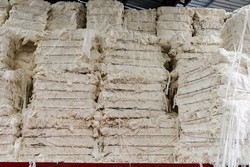Cellulose used for self-assembling rigid foam structures
Cellulose is the main structural component of plants and the most commonly occurring organic compound on Earth. Furthermore, processing cellulose fibrils from forestry or paper mill waste under carefully controlled conditions can release highly crystalline nanoparticles known as ‘nano crystalline cellulose’. The EU-funded project NCC-FOAM(opens in new window) (Self-assembly of nano crystalline cellulose for lightweight cellular structures) developed a unique technique for self-assembling NCC into highly ordered ‘puff pastry-like’ layered cellular structures. The goal was to create a durable, renewably-sourced NCC foam/resin composite that can be used in the design, development and processing of structural foam materials. Controlled patterning of the nanostructure during the self-assembly process helps the infusion of the resin. This provides stiffness and strength and the production of foams with customised internal structures and directional strength. The self-assembly process can thus be controlled to produce tailor-made structures based on end application requirements. The inherent strength of the NCC skeleton means that only minimal quantities of reinforcing resin are required to give lightweight cost-effective foams. Researchers successfully developed bio-based binders to strengthen the self-assembly of the NCC into virgin foam materials producing panels in the dimensions of 200 x 300 x 10 millimetres. This enabled the scale up of the foam production process with the infusion of the polymer into the foams. Test results confirmed the potential of the NCC foam as a basis for the production of lightweight sandwich components for application in the maritime and construction sectors. Life cycle analysis results showed that NCC foam offers environmental benefits through energy savings, by replacing steel and mineral wool in maritime applications, thereby reducing weight. NCC-FOAM represents a major breakthrough in sustainable rigid foam technology by bringing production techniques closer to industrialisation.







